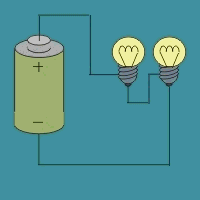
Figure #1 |
Electricity flows from the negative
side of the battery to the positive
side of the battery. Remember, the negative side of the battery has a
surplus
of free electrons. When a circuit is completed (closed) the electrons
want
to flow to the positive side of the battery. Very similar to the way
water
wants to flow from a high pressure area to a low pressure area. Once
the
electrons have become evenly dispersed throughout the battery, it will
not have a higher charge on one end... we call that a "dead" battery.
When a battery is recharged, the electrons are
stripped from the positive
side and deposited on the negative side. Batteries use a chemical
reaction
to distribute the electrons so eventually the chemicals wear out and
the
battery cannot be recharged anymore.
|

Figure #2 |
This configuration is called a series circuit.
The electrons must flow
through both of the light bulbs before returning to the battery. The
resistance
or force exerted against the electrons is now twice that of the circuit
in figure #1. Each lamp will therefore get a smaller voltage, half in
this
case, and will glow less brightly.
The force that works against electron flow is
called resistance. The
higher the resistance, the lower the current.
Each bulb will only get half the current as
figure #1, but because there
are two bulbs, the total current remains the same as for figure #1. If
we were to measure the voltage from the cathode (-) to the anode (+),
then
measure the voltage from the cathode (-) to the point between the two
bulbs,
we would find that it was about half as much. This is because one of
the
bulbs is using half the voltage to function.
|